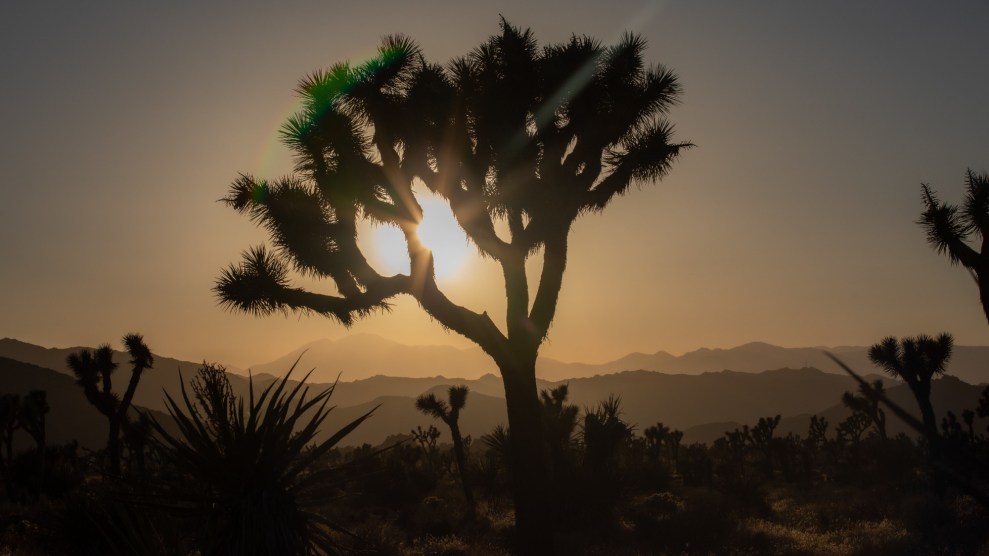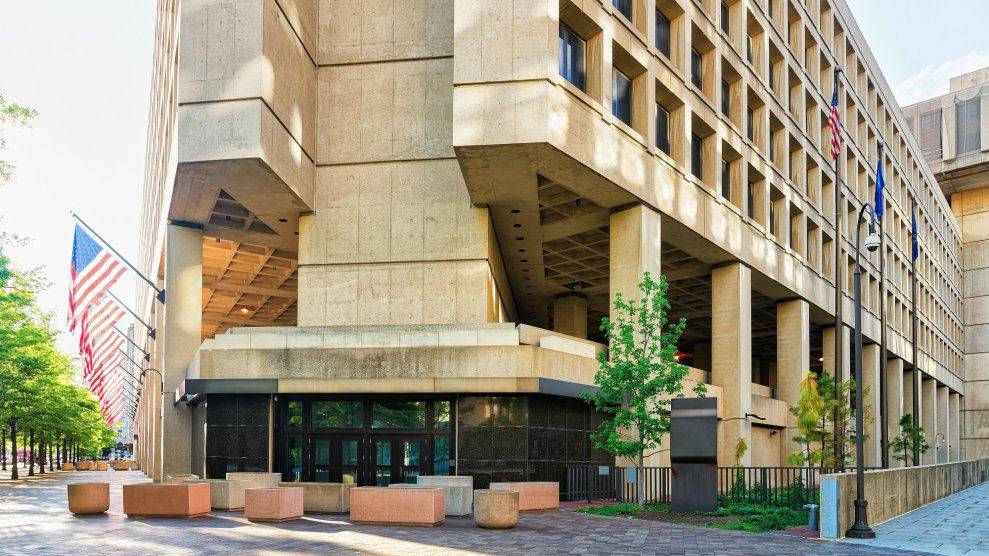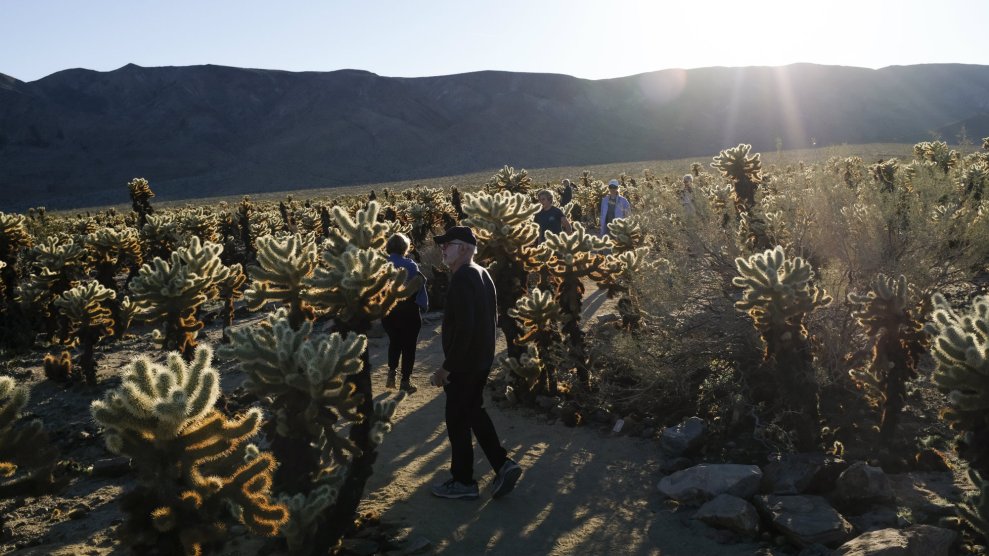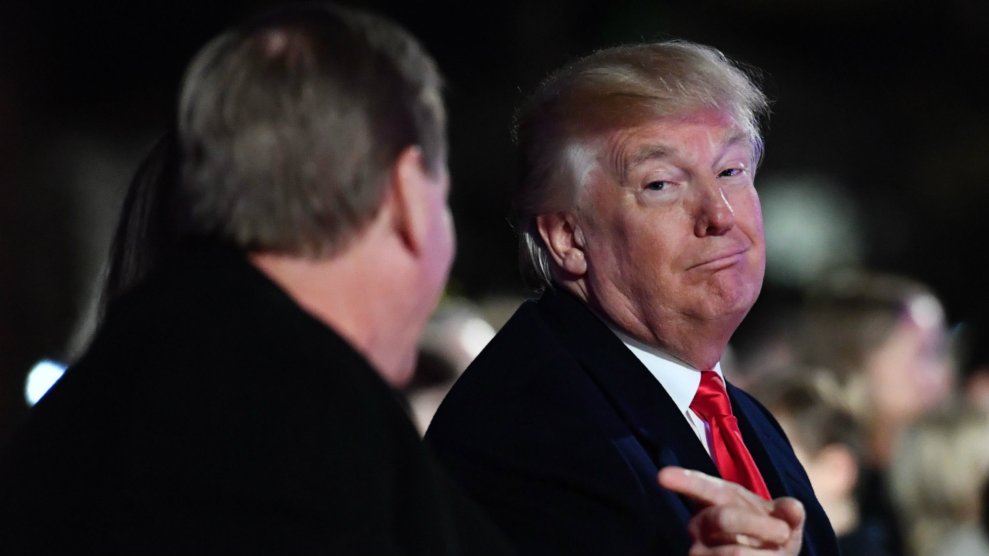
August 30, 2020, Joshua Tree, California, United StatesAurora Samperio/Zuma
This story was originally published by the Guardian and is reproduced here as part of the Climate Desk collaboration.
By the time superintendent David Smith decided to close Joshua Tree national park on January 7, 2019, the list of problems was already long. Tire tracks wove through the wilderness mapping a path of destruction where rare plants had been crushed and trees toppled. Charred remains of illegal campfires dotted the desert, and historic cultural artifacts had been plundered. Trash piles were growing, vault toilets were overflowing and park security workers were being pushed to their limits.
It was week three in what would become the longest shutdown of the US government, and the famed California park was feeling the consequences of operating without key staff, services and resources. To protect the park and its workers, it would have to close, Smith thought.
But the Trump administration, which demanded national parks remain accessible throughout the shutdown, wasn’t willing to change course. In a controversial move, David Bernhardt, who had only recently been appointed acting secretary of the interior, called Smith and ordered him to keep the gates open.
By the end of the 35-day shutdown, irreversible damage had been inflicted on Joshua Tree’s ecosystems, its wild, remote landscapes thrust into the political turmoil unfolding thousands of miles away.
Bernhardt’s decision and its aftermath are chronicled in hundreds of pages of emails between park officials, which the Guardian obtained through a records request. The correspondence sheds light on the pressure national parks faced during the shutdown, as well as how political considerations influenced decisions about their maintenance and protection.
Another possible government shutdown looms, raising fresh questions about whether the National Park Service (NPS), the federal agency that oversees the parks, will follow the precedent set by the previous administration.
“The situation right now is deeply concerning on many levels, including the potential threat to resources and visitors,” said John Garder, the senior director of budget and appropriations at the National Parks Conservation Association, a non-profit that advocates for park preservation. “It is difficult for the parks service to do their jobs when Congress doesn’t give them the resources they need.”
There have long been tensions over the interpretation of the NPS mission, with an uneasy balance of conservation and recreation. As politicians switch priorities, priorities in the parks can switch with them, and at the end of 2018 the NPS found itself in the crosshairs.
On December 21st of that year, Mick Mulvaney, who headed the office of management and budget for the Trump administration, announced the shutdown in a memorandum to agency leaders across the country, advising them that all talking points should reflect that the “national parks will remain as accessible as possible”. Communications staff for NPS’s Pacific west regional office followed up with instructions: “Keep the message positive, avoid saying limited access.”
Regional NPS leaders meanwhile told superintendents in close-of-day emails they were aware of the potential for damage to delicate ecosystems and park infrastructure if parks stayed open without the necessary resources, and possible danger to largely unsupervised visitors. The timing of the shutdown, which left employees furloughed or working without pay during the busy holiday season, only added to the challenges, Sarah Creachbaum, the acting deputy regional director, wrote in an email on December 23.
“If the shutdown does persist for more than a few days it will be increasingly important to keep an eye out for signs and symptoms of stress among your teams,” she said. “Uncertainty and stress are legitimate health and safety issues that can affect everyone.”
There would be weeks to go.
As the shutdown progressed, and the situation at some national parks turned increasingly dire, the NPS leaders told park superintendents they would support decisions to shut parks down, especially in situations where staff and visitors could not be kept safe.
“We’ve heard from many parks across the region that they are struggling more and more with trash accumulation, human waste, traffic congestion, fatigued employees etc,” wrote Stephanie Burkhart, the associate regional director of the Pacific west region on December 28. “As the shutdown continues, these challenges will get harder. So please continue to evaluate your capacity and resources, rotate staff to provide rest and implement area closures as needed.”
Two days later, Smith, the Joshua Tree superintendent, reached out to Creachbaum, Burkhart and communications staff to say he had decided to close campgrounds and a day-use area at the park after the start of the new year. The holidays were peak visiting times for the California site. With just nine working staff members, a disaster seemed imminent, he warned. Already, he reported, two search-and-rescue operations had been needed the week before, both requiring helicopters because the park hadn’t been able to adequately respond.
Staff had told him that visitors were resisting direction, telling law enforcement rangers they could do whatever they wanted during the shutdown. Staff members were increasingly concerned about their own safety, especially as incidents of intoxication and physical assaults in the park began to rise.
Staff who worked at Joshua Tree national park at the time said the experience was among the most difficult in their careers. “What I witnessed at the park was chaos and destruction,” said one park employee who, like others quoted in this story, asked to remain anonymous out of fear of retribution for speaking out.
From the start of the shutdown, the majority of the park staff had been opposed to keeping Joshua Tree open, they said, describing long days of work and feeling despondent as some visitors abused their unfettered access.
Another employee said decision-makers seemed out of touch with the reality on the ground: “In the lower rungs nothing made sense to us—you are just executing these orders that make no sense for the park, no sense for the visitor, and no sense for the employees.”
National parks are required to be ready for events like a shutdown with a contingency plan. But the controversial directions from the Trump administration forced the agency and the parks to make in-the-moment adjustments.
Four days before Smith informed NPS leaders of his intention to fully close Joshua Tree, the Pacific west regional NPS team were maintaining in staff emails that they would support park closures for heath and hygiene reasons, to protect visitor safety or due to staff fatigue. “As we come to the end of our second week of the closure, and with no end in sight, it is clear that keeping all park areas accessible is not feasible,” Creachbaum wrote to superintendents on January 3. “Now is the time to determine if the NPS contingency plan triggers for closures apply to your circumstances.”
But on January 5, Bernhardt intervened, issuing a memorandum to the deputy director of the NPS instructing him to modify the contingency plan so parks would rely on Federal Lands Recreation Enhancement Act funds to stay open. FLREA funds, which come from park fees, are designated by law to be used to improve the parks, including hacking away at a large maintenance backlog, estimated at roughly $12 billion across all parks at the time.
Bernhardt ordered that they be used for maintaining operations “until such funds have reached zero balance.”
The Government Accountability Office would later deem Bernhardt’s move to be a violation of the law. In a scathing report issued in 2019, the GAO concluded that Bernhardt’s decree had undermined congressional power of the purse and sidestepped laws outlining shutdown procedures. The interior department maintains Bernhardt’s decision was legal, and in 2020 the Trump administration’s Office of Management and Budget laid out a legal argument supporting Bernhardt and his decision.
“The decision to utilize FLREA funds in 2019 was entirely lawful,” Cole Rojewski, a lawyer speaking on behalf of Bernhardt, said, pointing to the OMB analysis. He added that if the action had been initiated from the beginning of the shutdown, the destruction of the park and dangers posed to both staff and visitors could have been avoided “while also allowing for continued public access and ensuring dedicated employees were paid throughout the duration of the shutdown.”
Raúl Grijalva, a congressman from Arizona, disagreed. As chair of the committee on natural resources in 2019, he wrote to Bernhardt admonishing him for the decision to use FLREA funds and questioned whether he had complied with the law outlining their use. Casting the former secretary’s act as a way to help “obfuscate the real costs of the shutdown,” Grijalva said the Department of the Interior’s actions “sidestepped Congress and used these park funds for political purposes.”
By January 6, superintendents across the system were rushing to carve out new plans to bring back furloughed staff using FLREA funds. Smith, meanwhile, still tried to quickly close Joshua Tree. On January 7 he requested a temporary closure from regional park leaders, highlighting the “considerable damage to park resources.” Creachbaum, the deputy regional director, responded: “I am so sorry about the damage to your park. It’s heartbreaking. We support the closure.” It would be her last email serving in the leadership role, and she stepped down soon after. A press release was drafted from Joshua Tree national park announcing a plan to close.
But the very next day, Smith wrote to Creachbaum’s successor, Katariina Tuovinen, alerting her that he’d been contacted by the director of the NPS, who had advised him Bernhardt would call him later that day. “The Secretary will be calling to order that the park stays open and that we use FLREA funds to do it,” Smith wrote in an email on January 8.
Communications officials at the national office scrambled to reframe the eyebrow-raising shift, issuing a new press release that cast the decision more favorably. “National Park Service officials have been able to avert a temporary closure of Joshua Tree National Park,” the release read, highlighting how revenue generated by recreation fees would be used to support the reopened campgrounds and entrance stations.
At the time, the NPS didn’t return calls and emails from the Guardian requesting comment on how this decision had been made. (The emails show they did connect with some reporters, asking the Los Angeles Times to make revisions to their reporting.)
Amid a growing likelihood the US government is headed for another shutdown on October 1, it’s unclear how the NPS is planning to respond.
In August, agencies across the federal government were expected to submit contingency plans. But the NPS has yet to confirm whether a new plan has been drafted and whether national parks will again be expected to remain accessible during the funding stalemate. Repeated requests for information and comment went unanswered from both the Department of the Interior and the National Park Service.
The Park Service operating budget is also under threat from budget cuts. As record numbers of visitors continue to flood in, the depletion of funds for maintenance and improvement could lead to more disastrous results, Garder argued. The maintenance backlog has only ballooned in recent years, growing from $11.6 billion during the last shutdown to more than $22 billion in 2022.
Jonathan Jarvis, a retired NPS director who served under the Obama administration and oversaw a 2013 shutdown, agrees. “When I was director, there was no question—you shut ’em down,” he said.
Jarvis, who spent four decades in the park service, said he hopes for a future where public lands aren’t put at risk by shifts in political whim, and advocates for the agency to be removed from the Department of the Interior.
Ultimately, he said, the future of US national parks will be linked to funding. “The good news is that in the US the parks are highly supported by the American people,” he said. “But they expect them to be taken care of.”















